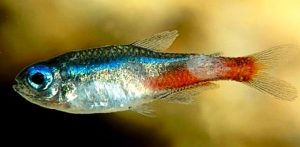Neon Tetra Disease (Plistophora hyphessobryconis) is a sporozoan parasite that infects neon tetras, cardinals, rasboras, angelfish, zebrafish, and other similar species. Regardless of what you have heard, there is NO CURE for Neon Tetra Disease.
A bacterial disease that infects Neon tetras, cardinals, etc. with almost identical symptoms is often misdiagnosed as Plistophora hyphessobryconis and can be cured with antibiotics, which is why some tropical fish keeping enthusiasts believe there is a cure for the disease.
PHYSICAL SYMPTOMS:
Fish infected with Neon Tetra Disease will appear restless, break off from the school, swim erratically, exhibit localized loss of color in a small area of the body, begin to waste away, and ultimately develop a kinked spine making it unable to swim normally.
The first sign of Neon Tetra Disease is a small patch of color loss on the body of the fish. Neon’s colors normally fade at night and this is normal, but when only one spot on the fish is faded or colored white and the rest of the fish’s color pattern is normal, the fish is likely infected. When the fish no longer swims or interacts with the school, the disease has already begun to affect the fish. Fish with these symptoms never recover.
CAUSE:
Neon Tetra disease is caused by the microsporidian parasite Pleistophora hyphessobryconis which infects the skeletal musculature causing muscle tissue damage which appears necrotic and white or marbled.
The disease is quickly transmitted through all fish in the aquarium once the fish consume the dead bodies of other infected fish in the tank or live foods like Tubifex or bloodworms, which act as a carrier of the disease.
Once the other fish in the tank eat particles of the dead fish or tubifex, the microsporidian spores enter the body of the fish and begin to consume the healthy fish.
The cysts begin to show up as a pale white color on the infected fish as the fish begins to deteriorate from the inside out.
Once you see symptoms on the fish, the fish is doomed and cannot recover.
TREATMENT:
There is currently no known treatment for Neon Tetra Disease (Plistophora hyphessobryconis).
Because there are a few bacterial diseases that have similar symptoms, many tropical fish keeping enthusiasts opt to remove infected fish from the tank and try anti bacterial treatments in a hospital tank with the hope that the infection is a similar bacterial infection.
If the fish recovers, it did not have neon tetra disease but a bacterial infection.
Euthanasia is generally the most prudent option as soon as Neon Tetra Disease symptoms are observed on an individual in the tank.
PREVENTION:
The only way to prevent the spread of Neon Tetra Disease is to remove any fish showing symptoms as soon as possible and euthanize it before the disease can be passed on to other fish in the aquarium.
The agent that causes Neon Tetra Disease can live for several months in an aquarium without a host. Any fish that can be infected by the disease should not be returned to the tank that had the disease for at least six months to prevent reinfection.
Neon Tetra Disease (Plistophora hyphessobryconis) is an extremely difficult disease to control.




